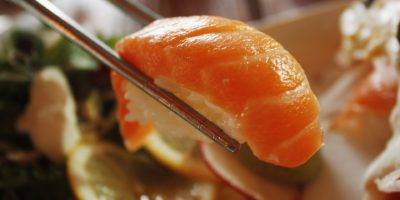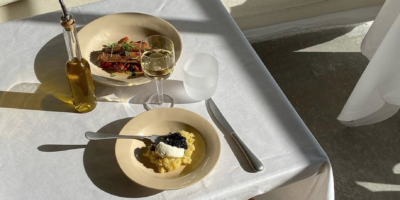Top 10 Thai Desserts

IMAGE SOURCED FROM PIXABAY.COM
It’s probably fair to suggest that when the topic of Thai food is mentioned, many people tend to think in terms of rice dishes like green curry, ‘tom yum goong’ or spicy somtum salad. Visions of rich, colourful, exotic, and spicy culinary creations from the tropical SE of Asia are usually conjured up, and of course this is not too far off the mark. However, Thai desserts are quite often overlooked as an integral part of the cuisine, and for those with a sweet tooth these after dinner treats can be a delightful experience of somewhat unique and intricate combinations.
Although they are usually based in some way around available local ingredients such as fruit and/or vegetables, rice, and coconut in various delineations and forms, there is also a range of other ingredients that may feature in some of these sweet dishes. These additions may be, to varying degrees, rice flour, beans (typically the mung or yellow soybean variety), taro, lotus seeds, palm sugar, ginger, and roots like that of the cassava.
The fruit is likely to be of the locally available, tropical variety such as bananas, mangos, and the slightly bizarre-tasting (and highly pungent) durian fruit. The rice that features so commonly as a base in many of these desserts, sweets and cakes is of the ‘sticky’ variety—‘khao-neow’ in Thai—sweetened, steamed, glutinous rice that often serves as the Thai equivalent of flour in Western desserts, cakes, and other flour-based delicacies.
The coconut angle is quite commonly in the form of coconut milk or cream (made from the flesh of the coconut) or the dried, dessicated, shredded form that is used for toppings; or it may even be chunks of raw flesh garnered from the inside of fresh green coconuts’ shells, sliced, shredded or chopped.
Many of these desserts also feature or contain eggs, which was a somewhat later addition in historical terms, related to the Portuguese influence on Thai eating habits.
It is a little-known fact even amongst many Thais, that the Portuguese, the first foreign visitors to the region, had a rather radical effect on Thai cuisine by being the ones responsible for bringing the chili to Thailand, along with small cakes and pastries that are still commonly found today.
Thai desserts are usually referred to by the somewhat general categorisation ‘khanom’ a term which also includes a variety of small cakes and snacks which may or may not be sweet. But Thai deserts per se are indeed a fitting way to round off any meal, and particularly one that was typically rich and spicy in nature, as is much Thai cuisine.
1. ‘Khao Neow Mamuang’ (Mango and sticky rice)

IMAGE SOURCED FROM PIXABAY.COM
Possibly the most well-known of all Thai desserts and certainly one of the most popular, is the in-credibly sweet and satisfying mango and sticky rice. Mango season is Thai summertime—the really hot period (around March to June) when the bright yellow, succulent mangos are at their most plentiful. They are sliced and chopped to varying degrees and served with sweet sticky rice, topped off with sweetened, thickened coconut cream and a handful of chopped, roasted yellow soybeans.
The price of this Thai dessert varies according to where it is purchased, but whether bought from expensive restaurants or street vendors, the sweet and filling mango and sticky rice is a firm favourite with both locals and visitors alike.

IMAGE SOURCED FROM PIXABAY.COM
2. Khao Neow Durian (Durian and sticky rice)

IMAGE SOURCED FROM CREATIVECOMMONS.ORG
Something of a variation on the mango and sticky rice theme is the exotic looking durian fruit and sticky rice. This Thai dessert is pretty much the same as the mango variety, although the durian fruit is somewhat more of an acquired taste than the bright, sweet summertime mango.
Durian is a strong-smelling Thai fruit unique to tropical regions and not that cheap even locally, and the taste is…well, unique. Durian is a high-calorie fruit with warming qualities, so not so much of a summer favourite as is its mango counterpart.
It is, however, hugely popular with (mainly Asian) tourists in Thailand and must be tried at least once when visiting this region, although it can some-times be quite expensive depending on the time of year and where it is bought.
3. Khao Tom Mud (Sticky rice cake)

IMAGE BY MARK PHILIP
Although this Thai dessert is sold in restaurants as an after-dinner treat, it can also be found quite easily on many of the vendor carts lining the streets of Bangkok and other regions of Thailand. Sold wrapped in the green banana leaf that it is steamed in (‘mud’ loosely translates as ‘wrapped’ in Thai), here is another exotic, filling, sweet sticky treat.
Comprised again of mainly sweet sticky rice, there is also a banana to be found in the middle and quite often some kind of bean (also found in many other Thai sweets), all of which has been wrapped in a banana leaf and steamed, with delightful results when considering the simplicity of it.

IMAGE BY MARK PHILIP
4. ‘I-teem Ga-Ti’ (Coconut milk ice cream)
Another firm favourite and something of a standard in terms of Thai desserts, this ice-cream is rich, sweet, and delightful, and often served in small, wispy scoops in the shell of a green Thai coconut for added effect. Made from coconut milk and flesh, and sold in small, inexpensive scoops by ‘walking cart’ street vendors, it is again often topped off with a delicate handful of yellow roast-ed soybeans, and this ice-cream (‘i-teem’ is the Thai pronunciation of ice-cream) is popular all year round with both locals and tourists.
This is another Thai dessert sold both as an after-dinner treat in expensive Thai restaurants and by street vendors (for a quarter of the price), and its exotic, cooling sweetness is found by many to be a surprisingly pleasing alternative to dairy ice-cream (which also makes it a firm favourite with those opting for plant-based diets). Another slightly bizarre variation of some of the walking street vendors is the ‘ice-cream sandwich’—literally two chunks of white bread with a wedge of the ice-cream in the middle, which is hugely popular with young Thais and children.

IMAGE SOURCED FROM KABOOM.COM
5. Khao-Neeow San Kaya (Sticky rice topped with egg custard)

IMAGE SOURCED FROM CREATIVECOMMONS.ORG
Not unlike the Khao Tom Mud, this Thai dessert is sometimes considered as a cake due to its small size, and Khao-Neow San Kaya is comprised of (the standard) sweet sticky rice as a base and topped off with Thai egg pumpkin custard, providing a delightfully sweet, moorish combination and texture.
Khao-Neeow San Kaya is also to be found both in restaurants and from street vendors, with the latter obviously providing the much cheaper option. Like its counterpart Khao Tom Mud, this Thai sweet is made and sold wrapped in the characteristically Thai green banana leaf as well, which serves many purposes in the culinary pursuits of Thailand.
6. ‘Khanom Krohk’ (Small Coconut Pudding)

IMAGE SOURCED FROM PIXABAY.COM
Khanom Krohk is yet another Thai dessert made mainly from coconut milk, this time mixed with slight amounts of rice flour and presented as a small, after-dinner pudding.
Many local Thai restaurants have these bite-sized Thai sweets stacked on the table ready for when diners finish their meal. As they are usually relatively inexpensive (around 10 baht – although this will depend on the establishment), it is not uncommon to see diners finish off anything from one to ten of them–paying the bill at the end of the meal then includes a count-up of the small, empty dishes that contained the desserts.
These Thai desserts have a texture not unlike that of custard, and provide a fitting end to any hot and spicy dish characteristic of much Thai cuisine. As a point of note, there is another slight variation on this pudding to be found in the form of a toasted, crispy version, often found on the carts of street vendors.

IMAGE SOURCED FROM CREATIVECOMMONS.ORG
7. ‘Khanom Buang’ (Crispy Taco Pancakes)

IMAGE SOURCED FROM CREATIVECOMMONS.ORG
This rather sweet dessert also doubles as an on-the-go sweet, take-away street snack and is commonly found on the carts of street vendors all over Thailand. It is easy to spot with its crispy, taco-like pancake base and bright white, creamy and sweet, coconut-based filling topped off with bright orange shreds of sweet egg-based strands.
These Thai desserts/cakes/snacks are hugely popular with locals as they are relatively inexpensive and are usually made fresh on the street – hence, if you find yourself ordering these in a more upmarket venue you can bet that you are paying through the nose for them. In terms of snacks these are typically Thai–colourful, exotic-looking, sweet and crunchy, and these particular Thai sweets are a treat for those with a sweet tooth who don’t care so much for fruit or some kind of Thai fruit or vegetable in their desserts.
8. ‘Guay Buat Shee’ (Boiled Bananas in Coconut Milk)

IMAGE SOURCED FROM CREATIVE COMMONS.ORG
This is another staple in terms of Thai desserts and contains slow-boiled bananas in coconut milk that is often sweetened. It may sound quite simplistic, but again comes in slight degrees of variation according to where it is bought-– hot or cold, with or without coconut flesh and/or roasted yellow soybeans, this well-known after-dinner treat is relatively easy to find and should not prove to be too expensive unless dining in an upmarket restaurant.
Anyone who has spent any length of time in Thailand may have found that the only real difference between the food served in upmarket restaurants and the more standard, ‘grass-roots’ local ones is often merely down to presentation.
9. ‘Bua Loy Kai’ (Rice Flour Balls in Coconut Milk)

IMAGE SOURCED FROM CREATIVECOMMONS.ORG
This is yet another coconut milk-based dessert with rice flour balls that float, and a variety of other sweet ingredients that may vary. The rice flour balls are soft, sticky, and usually in a variety of bright, striking colours such as green, yellow and pink, and some of the other common additions to the milk may include pumpkin, taro, pandan, corn, beans or fruit, making it a sweet and colourful-looking affair.
Like many other Thai desserts this one may also contain egg in some form (syrup-poached being a common one), and sometimes there are variations on the flavouring of the rice balls such as adding a ginger twist to them. Served hot or cold, this is one Thai sweet that has a typically Asian twist to it with its bright colours and hotch-potch of floating ingredients, some of which might not be that familiar to Westerners—but it is definitely still worth a try for anyone looking for new or dif-ferent variations on the sweet theme.
10. ‘Fak Thong Khaeng Buat’ (Sweet Pumpkin in Coconut Cream)

IMAGE SOURCED FROM CREATIVECOMMONS.ORG
‘Fak Thong’ is the Thai word for pumpkin, and this is a vegetable that may feature quite heavily in a lot of Thai dishes including the sweet ones. For those who may be put off by the idea of a vegetable being in a dessert dish, it is worth noting that the pumpkin variety found in Thailand is closer in taste and texture to a squash (particularly the Japanese Kabocha) than the Western variety. With its sweet flavor and soft, almost fluffy texture, it is a useful addition to many dessert dishes, with this one being no exception, and it also features as an ingredient in Thai ‘custard’ such as that top-ping the ‘San Kaya’.
The coconut milk is usually unsweetened, but it has palm sugar added to it (and sometimes normal sugar as well), which is one of the reasons why Thai desserts are often so incredibly sweet. Fak Thong Khaeng Buat is a typical example of a popular local dessert amongst Thais that was a standard long before the introduction of Western-style cakes and sweets into the region.
Planning a trip to Paris ? Get ready !
These are Amazon’s best-selling travel products that you may need for coming to Paris.
Bookstore
- The best travel book : Rick Steves – Paris 2023 – Learn more here
- Fodor’s Paris 2024 – Learn more here
Travel Gear
- Venture Pal Lightweight Backpack – Learn more here
- Samsonite Winfield 2 28″ Luggage – Learn more here
- Swig Savvy’s Stainless Steel Insulated Water Bottle – Learn more here
Check Amazon’s best-seller list for the most popular travel accessories. We sometimes read this list just to find out what new travel products people are buying.










